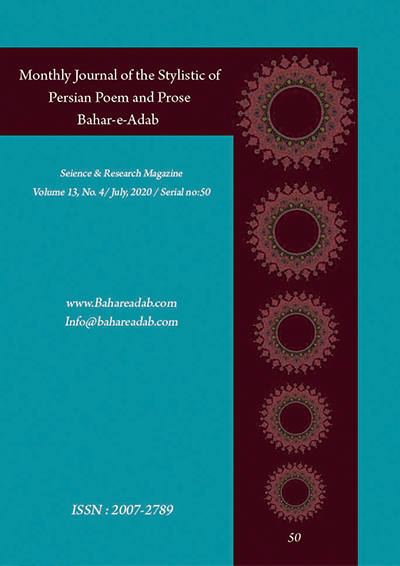- Count View : 293
- آدرس کوتاه شده مقاله: https://bahareadab.com/article_id/358
Journal of the stylistic of Persian poem and prose
volume Number 13،
number In Volume 4،
،
issue Number 50
Abolfazl Zarroi Nasr Abad's satirical ways in "Rofouzeha"
Maryam Parakandeh, Yadolla Bahmani Motlagh(Author in Charge), Aliakbar Afrasiabpour
Abstract
In this article, an analytical descriptive method has been used to study the satirical techniques of contemporary poet, researcher and satirist Abolfazl Zarroie Nasrabad in a collection of essays that almost cover all of his tales. In this work, Zarroi has been able to use different techniques of satire, including the use of interlaced language, funny imitation of others" poetry, prayer, playing with words, using humorous position, destroying symbols, mocking and treating others Exaggerating praise for others, the use of non-rickety sophistication, the mention of seemingly irrelevant reasons, ironic teasers, humorous accusations, highlighting, writing satirical footnotes in explaining your poems, likening humans to animals, and helping to gain weight and empty spaces in The poetry of his social political ideas. In a series of rhetoric, Zaravi finds the social dilemma in a state of distress for people and draws the heavy burden of these misfortunes in a seemingly bitter language from the reader"s heart and soul, and in various forms, with a fluent language, he lushes joy and laughs on his lips, Literary critic.
Keyword
Social satire
, Abolfazl Zarroie Nasr Abad
, Rofouzeha
, satirical ways
- Okhot, Ahmad (1992), Semiotics of Mataybeh, Isfahan: Farda Publications
- Aslani, Mohammad Reza (2006) Dictionary of Comic Vocabulary and Terms, Tehran: Caravan
- Javadi, Hassan (2005), History of Humor in Persian Literature, Tehran: Caravan
- Hosseini Kazeruni, A (2011), satires of Persian literature and its types, Bahar Adab Quarterly, Volume 4 Number 1 Page 99
- Halabi, Ali Asghar (1985), An Introduction to Humor and Humor in Iran, Tehran: Peyk
- ........... (1998), History of Humor and Humor in Iran and the Islamic World, Tehran: Behbahani
- Khazail, Hassan (2005), World Literature Culture, Tehran:kolbe
- Dachak, M., Investigation of structural structural features of humor in radio programs, Master Thesis, Tehran: Payame Noor University of Tehran Center (2008)
- Dad, Sima (2006), Dictionary of Literary Terms, Tehran: Morvarid
- Dubro, Heather (2010), Genre, translated by Farzaneh Taheri, Tehran: Markaz
- Zarvi Nasrabad, Abolfazl (2012), Refusehs, Tehran: Neystan
- Seyed Hosseini, Reza (2006), Literary Schools, Tehran: Negah
- Shadordi Manesh, M (2005), Methods and Techniques of Humor and Comparison, Journal of Persian Language and Literature Education, Volume 18 Issue73
- Safavi, K (2005), An Introduction to Humor from a Linguistic Perspective, Azma Magazine, No. 36
- Mojabi, Javad (2004), Iranian Nishkhand, Tehran: Rozaneh
- Nikobakht, Nasser (2001), Satire in Persian Poetry, Tehran: University of Tehran
- Vahidian Kamyar, Taghi (2000), Innovative from an Aesthetic Perspective, Tehran: zemstan Publishing

